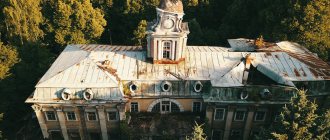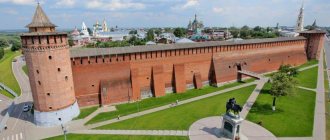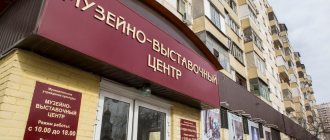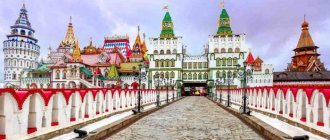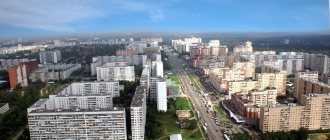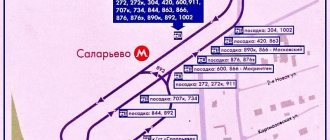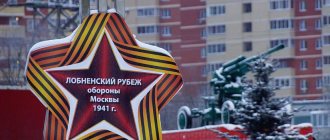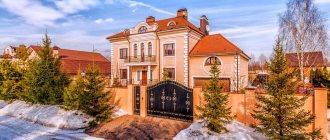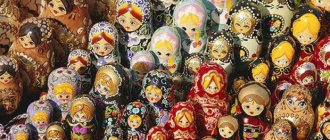TOP-3 – what to visit in Zhukovsky in 1 day
The tour should start with the main attractions of the city, which fully reflect its history, culture and values. You can visit them in one day.
Museum of the History of the Central Aerohydrodynamic Institute (TsAGI)
- Address: st. Zhukovsky, 1.
In 1964, a museum was opened in the TsAGI House of Scientists, telling about the creation and development of Russian aviation. The museum's large-scale collection includes photographs and documents related to the founding and subsequent history of the institute.
Here you can see models of the first aircraft, portraits of the designers and elements of the pilots' uniforms. The exhibition of experimental aircraft is of great interest.
The museum continues to expand, adding exhibits that testify to the modern achievements of the center. Its goal is not only to preserve the memory of the past, but also to inspire young people to choose the profession of pilot.
Church of the Transfiguration
- Address: st. Gagarina, 77A.
In the early 2000s, the number of parishioners in churches in Zhukovsky increased, resulting in the need to build a new large church. Thus, the Church of the Transfiguration appeared.
At the council of artists and architects, it was decided to bring the building closer to the Assumption Cathedral of the Moscow Kremlin. The church turned out to be quite spacious, similar to ancient temples, and its design made it possible to create a rich ornament.
The Transfiguration Church is a smaller copy of the Assumption Cathedral. It is also decorated with a zakomari ceiling, arched portals and a golden five-domed dome on light drums. Nowadays the temple operates and is the largest in Zhukovsky.
Monument to N.E. Zhukovsky
- Address: Lenin Square.
Nikolai Zhukovsky was remembered by posterity as the founder of hydroaerodynamics. It is not surprising that the aviation science city was named after him.
In other cities, on Lenin Square there is a sculpture of the Father of the Revolution, while in Zhukovsky there is a monument to the Father of Aviation.
The sculptor depicted Nikolai Yegorovich in a thoughtful pose, wanting to capture the birth of great ideas. The monument was opened in 1969 and has since been a symbol of the city.
Don't miss: Sights of the Moscow region
Death
Vasily Andreevich Zhukovsky lived in Baden-Baden for a long time. In 1851, illness came to him. One of the writer’s eyes could no longer see, so the creator was recommended to spend more time in a dark room. Despite health problems, Vasily Andreevich passionately wanted to return to his homeland - to Russia. Chaadaev and Gogol supported the writer in this.
Grave of Vasily Zhukovsky
On July 14, 1851, the Zhukovsky family was supposed to hit the road, but this did not happen because the man’s eye became inflamed. Vasily Andreevich could not write or read on his own. The writer was assisted by his wife and valet. Zhukovsky’s health was rapidly deteriorating, so the author of poems and ballads asks Vyazemsky to come to Baden.
Vasily Andreevich finally fell ill after Gogol’s death. And on April 12, 1852, the writer himself died. The author of the fairy tales “About Tsar Berendey” and “The Sleeping Princess” was buried in a special crypt, on the walls of which lines of his poems were carved. Knowing the writer’s love for Russia, in August 1852 the valet transported Zhukovsky’s ashes to St. Petersburg. Now the grave of the poet, translator and teacher is located at the Tikhvin cemetery of the Alexander Nevsky Lavra, not far from the grave of N. Karamzin.
Cultural places of Zhukovsky
In addition to attractions related to aviation, Zhukovsky is famous for theaters and cultural centers with a rich history.
City Palace of Culture
- Address: st. Frunze, 28.
In 1959, the House of Culture was founded in Zhukovsky, which served as an impetus for the development of youth talents. It is made of brick and decorated with a portico with a colonnade. It houses an auditorium, a small concert hall, and a Pink Living Room for intimate events.
There are many creative clubs operating at the House of Culture. Children and teenagers are taught stagecraft, vocals, playing musical instruments and choreography. They regularly participate in performances and concerts held on the stage of the Zhukovsky Palace of Culture.
Art salon “Fifth House”
- Address: st. Zhukovsky, 5.
In 1992, an art gallery appeared in Zhukovsky. Its purpose is to hold exhibitions, promote local artists, various art auctions and educate young people.
Every year, the “Fifth House” hosts about 20 exhibitions on various topics: children's, author's, photo exhibitions. The gallery hosts an art club that can be attended by anyone, regardless of age.
What museums are worth seeing in Zhukovsky
Most of the science city's museums are dedicated to aviation and technology in general, however, you can find completely unexpected exhibitions here.
Museum of the History of the Conquest of the Sky
- Address: st. Chkalova, 41.
The museum was opened in 1979. Since then, it has preserved not only the past of the city, but also the history of the development of domestic aviation. The exhibition occupies two halls. At the beginning you will find a story about a man’s first attempts to fly into the air and the success that his perseverance and work brought.
The highlight of the exhibition is the collection of pilot uniforms, which were used from the beginning of the 20th century to the present day. Tourists will also see protective masks, oxygen cylinders and pressure helmets worn by heroic pilots of the Great Patriotic War. These exhibits were donated to the museum by the pilots themselves or their families.
The second exhibition is called “Feel like a pilot.” There is a flight simulator here. It provides an opportunity to test yourself in piloting an aircraft and take part in air combat.
Also in the hall of the attraction there is a suspension system for a rescue parachute, a wind tunnel and a pilot's room of a civil aircraft. All this exists for the sake of complete immersion of tourists in the atmosphere of flights. In addition to the exhibition halls, the museum has a lecture hall and a cinema.
Museum of the History of the Research Institute of Instrument Engineering named after. V.V. Tikhomirov
- Address: st. Gagarina, 3.
The museum is located in the central part of Zhukovsky in the building of the research institute. Its exhibition tells the story of the creation and development of instrument making. At the beginning, tourists are introduced to the developments of V.V. Tikhomirov, followed by more modern exhibits.
While visiting the museum, tourists will get acquainted with the history of the development of anti-aircraft guns and radar systems. At the entrance to the museum there is a Buk anti-aircraft missile system, with which tourists take pictures.
Elephant Museum
- Address: st. Gagarina, 77a.
The only Elephant Museum in Russia is located in Zhukovsky. Its collection includes more than 5,000 exhibits. Tourists will see elephant figurines of all shapes and sizes. They are made of wood, earthenware, bone, metal, plastic, leather, wool, wax, crystal and shells.
Paintings, wood-burning designs and embroidery depicting elephants are exhibited here. The museum's collection is constantly updated. In addition to conducting excursions, he collects interesting facts about elephants and participates in charitable activities.
Best on the site: Sights of Moscow
Literature
The creative path of Vasily Zhukovsky was thorny and difficult. The writer could not make a living from poetry or prose, so he took up translations. Zhukovsky's talent in this field was highly appreciated by his contemporaries, including Platon Beketov, the owner of the largest printing house. While still at the Moscow University boarding school, Vasily Andreevich met Nikolai Karamzin, who became a teacher and mentor for Zhukovsky for many years.
Nikolay Karamzin
The reformer of the Russian literary language considered it his duty to criticize the work of his ward. But Karamzin did not forget about praise. The teacher always noticed successful statements and phrases used by Zhukovsky in his works. From 1808 to 1820, the poet was in a romantic and artistic search.
This is clearly manifested in the ballads of that time, for example in “Lyudmila”. Interestingly, the work is a creative translation of the work of the German poet G. A. Burger. In “Lyudmila” Zhukovsky reveals the lyrical moods present in his life.
Ivan Krylov, Alexander Pushkin, Vasily Zhukovsky and Nikolai Gnedich in the Summer Garden
It took Vasily Andreevich 4 years to create the ballad “Svetlana”. The poem is based on “Lenora”, created by G. A. Burger. The work differs from “Lyudmila” in its cheerfulness and fun. Zhukovsky's friend A.S. Pushkin highly appreciated the work of the master.
Translations remained an integral part of Vasily Zhukovsky’s life. The poet had a natural gift that allowed him to translate the best poems and ballads of world literature. Vasily Andreevich fully revealed the traditional German fairytale and conveyed the magic of I. Goethe’s poem “The Forest King” during the translation into Russian.
Book by Vasily Zhukovsky
Zhukovsky liked to create, so the writer often translated the works of famous poets, but at the same time did not forget about his own creativity. In 1822, Vasily Andreevich introduced the society to an elegy created in the spirit of romanticism - “The Sea”. The author conveyed in words his admiration for the beauty that surrounds people. Later, Zhukovsky began translating the ballad “Cup”, created by I. Schiller. The translator worked on the work for 6 years. In those days, there was no need for a literal retelling - it was enough to convey the meaning, sensations, and emotions of the work.
Poems by Vasily Zhukovsky
From time to time, Vasily Zhukovsky helped children comprehend science, including literature. Close communication with boys and girls of different ages prompted me to write fairy tales. It took Zhukovsky about 30 years to create seven fairy tales, which to this day remain popular among adults and children. Among the works of Vasily Andreevich are “The Red Carbuncle”, “The Tale of Tsar Berendey”, “The Sleeping Princess”, “The War of Mice and Frogs”, “Tulip Tree”, “Puss in Boots”, “The Tale of Ivan Tsarevich and the Gray Wolf” .
Meeting in the office of Vasily Zhukovsky
In fairy tales, Zhukovsky preferred to go for bright experiments. The writer used figurative and expressive means of language and played with poetic meters. Vasily Andreevich was fascinated by unreal, mysterious and partly scary worlds, which were clearly manifested in the works of Tieck, Novalis and Hoffmann. This was reflected in Zhukovsky's tales.
Tales of Vasily Zhukovsky
Sometimes the writer became interested in the national poetic movement. The creator tried to combine the mystery of Europe and local folklore in fairy tale books. A year before his death, Zhukovsky writes two magical poems, “The Cat and the Goat” and “The Bird.” The author dedicated the work to his daughter and son.
Ancient architecture: where to take a photo in Zhukovsky
There are not many old houses in the city of Zhukovsky. Most of them are located in nearby villages. Architecture fans will be interested in making a similar trip.
Drama Theater "Strela"
- Address: st. Kirova, 3.
The theater building is one of the oldest in the city. It was built at the end of the 19th century as a sanatorium for railway employees. During the war years it was occupied by a hospital, and later a theater settled here. The building has retained its original features: a slender colonnade, a veranda with a balustrade, a stone fountain in an antique style.
Today, performances are held here, in which professional actors take part. The theater also hosts musical concerts, military-patriotic events and spectacular shows. Moscow bands often give concerts on this stage.
Bykovo Estate (Maryino)
- Address: Ramensky urban district, Bykovo village.
In the village of Bykovo there is one of the most impressive architectural complexes in the Zhukovsky region. The estate was founded in the 14th century, and acquired its final appearance during the reign of Nicholas I. At different times, it was owned by the princes Vorontsov, Izmailov and Ilyin. The architectural ensemble includes stone buildings in the styles of classicism, gothic, historicism and neo-renaissance. These are mansions, outbuildings and outbuildings. The most significant structures are:
- The Vorontsov-Dashkov estate is a two-story mansion with towers, risalits and an expressive balcony. The rich decor includes colonnades, architraves with sandstones, arched portals and stucco coats of arms of the Vorontsov family.
- Temple of the Vladimir Icon of the Mother of God. The temple was built in the Russian Gothic style and attracts attention with sharp spiers, lancet windows and two bell towers, which, like towers, stand on the sides of the main building. The temple is placed on a high basement with a double staircase.
After the revolution, a children's colony and a school for bombers operated in the complex. The building was vandalized by students. Gradually, interior items, books from the library, a bust of Catherine II and a column of Alexander I were lost. The interior decoration was completely destroyed, like many buildings. The only surviving element of the park is the rotunda.
After the Great Patriotic War, a tuberculosis sanatorium was established in the estate. There was a library and a gym here, and the greenhouse was partially restored. Currently, the estate is recognized as an architectural monument of regional significance. Restoration work is being carried out there at a slow pace.
Temples, churches and cathedrals of Zhukovsky
An integral element of the appearance of the city of Zhukovsky are churches built in different architectural styles.
Church of the Icon of the Mother of God "Iverskaya"
- Address: 4th microdistrict.
The Iverskaya Church was built in 1999 in the style of wooden architecture of the 17th century, thanks to which it resembles the ancient churches of central Russia.
The building is a log house with vestibules and a shed under a high tent. The porches cover traditional barrels. The building was built as a baptismal temple at the Church of Panteleimon the Healer.
Church of the Icon of the Mother of God "Derzhavnaya"
- Address: Nizhegorodskaya st., 17, holiday village Kratovo.
The church is located in the village of Kratovo. Its story began in 1995 with an unusual discovery. From the words of an old resident of the village, it became known that on the outskirts of Zhukovsky there is a brick building built before the revolution.
The unfinished one-story building was supposed to become a temple, but the work was interrupted by the First World War. After the revolution, no one thought about building a church, so the brick building was turned into a store, then a warehouse.
In 1999, it was decided to revive the construction of the temple. A year later, a new church appeared in Kratovo. One of its chapels was consecrated in honor of the Tsar-Martyr Nicholas II.
The building is made in the Pskov-Novgorod medieval style and has a cruciform shape. On four sides the facades are completed with gables. In the center of the eight-slope roof there is a light drum under a helmet-shaped dome. The rooms are illuminated using narrow windows.
The ceiling and walls are decorated with paintings in a medieval style. A century-old brick structure still stands next to the church. During the construction of the new building, it served as a temporary temple. Now it serves as a monument of history and architecture.
Church of the Intercession of the Blessed Virgin Mary
- Address: st. Chkalova, 26A.
The Intercession Church was erected in 2007 on the territory of the central hospital. The building is designed in an eclectic style and is decorated with pilasters, false windows and archivolts. Above the main entrance there is a belfry with small bells.
The composition is completed by a massive six-piece with molded garlands and a light drum under a golden dome. The internal vaults are decorated with bright frescoes with biblical scenes.
There is a park around the church with well-groomed groves and cozy places to relax. Its main attraction is the Il-103 monument, a four-seater single-engine aircraft also known as an “air taxi”.
Biography
Russian writer, poet, translator Vasily Andreevich Zhukovsky was born on February 9, 1783. Fame came to the creator thanks to translations and fairy tales “The Sleeping Princess” and “The Tale of Tsar Berendey”.
Portrait of Vasily Zhukovsky
There are legends about the birth of Vasily Zhukovsky. It is known that the parents of the talented writer were the second major and landowner of the Oryol, Tula, Kaluga provinces Afanasy Ivanovich Bunin and the Turkish woman Salha, who after baptism received the name Elizaveta Dementievna Turchaninova. Historical references say that the man was married to Maria Grigorievna Bunina. But the union did not bring an heir to the landowner. This became the reason for betrayal with his concubine Turchaninova. The girl gave the desired son to Bunin.
Andrei Grigorievich Zhukovsky adopted the boy, despite the fact that the court knew who Vasily’s father was. My stepfather was one of the impoverished Kyiv landowners. Literary historian I. Yu. Vinitsky believes that the situation with the birth of the heir was more complex than represented in numerous biographies of the writer.
Vasily Zhukovsky in his youth
At the age of 2, Vasily, at the request of his father Bunin, became a sergeant of the Astrakhan Hussar Regiment. After 4 years, they announced the issuance of a new rank to Zhukovsky - ensign. Soon after this, the young soldier is sent into retirement. In 1789, teacher Ekim Ivanovich comes to the boy. Unfortunately, the German did not have the proper teaching skills, so his adoptive father Andrei Zhukovsky took over the training.
A year later, the Bunin family moved to Tula. Pokrovsky's teacher is immediately invited to Vasily. The teacher at that time was known as a writer and a fan of classicism. But Zhukovsky’s restless character led to Pokrovsky refusing to work with the young man. The teacher told Vasily’s father that the guy had no talent, so there was no point in teaching.
Vasily Zhukovsky in his youth
Afanasy Bunin's inheritance passed to his daughters after his death. Zhukovsky received 10,000 rubles. At that time this was a significant amount. For another year after the death of his father, Vasily attended the Rode boarding school, then passed the exams for admission to the Main Public School. After several months of studying at the institution, Zhukovsky is expelled for his inability to comprehend science.
Vasily decides to move to his half-sister Varvara Yushkova. On the territory of the young woman’s estate there was a home theater. Here Zhukovsky first realized that he wanted to become a playwright. In 1794, the writer created the first tragedy based on Plutarch’s plot, “Camillus, or Rome Liberated.” Later, a melodrama appears from Vasily’s pen, based on the novel “Paul and Virginia.”
Young Vasily Zhukovsky
Home education could not provide the necessary knowledge to Zhukovsky, so his stepsister sends Vasily to the Moscow University boarding school. During the exam, the poet demonstrated a high level of proficiency in French and partly German. The boarding house committee appreciated his knowledge of literature. At the university, Zhukovsky became friends with Andrei Turgenev. The young man significantly influenced the writer’s further work. At the boarding house, Vasily Andreevich writes his first poems, including “May Morning.”
Zhukovsky: main memorials to pilots
In the city of aviation, most of the memorials are dedicated to the pilots who died during the First and Second World Wars, aircraft designers and the aircraft themselves, who also left their mark on the history of Russia.
Monument to the Tu-144 aircraft
- Address: Tupolevskoye Ring.
Tu-144 is a Soviet passenger aircraft. At one time, it was the pride of the USSR and a symbol of the success of domestic aviation. A monument to this aircraft was opened in Zhukovsky in 2022. An authentic car produced in the early 1980s is placed on the pedestal.
Monument to the MiG-21 aircraft
- Address: Mendeleev street.
At the intersection of Gagarin and Mendeleev streets there is a MiG-21 fighter placed on a stele. This model was developed in the 1950s and protected the Russian sky for a long time.
After decommissioning, the steel bird was donated to the aviation science city as a monument. Today it is one of the city's most famous landmarks. It’s a rare tourist who doesn’t take a photo with the MiG-21 in the background.
Memorial Bykovskoye Cemetery
- Address: Magistralnaya st., 31.
The cemetery was probably founded in the 18th century. Burials from the 19th and 20th centuries have been preserved here. In 1992, the cemetery was given memorial status, as there are many historical monuments and military graves on its territory.
Since the founding of Zhukovsky, there has been a tradition of burying test pilots, cosmonauts, aircraft designers and TsAGI employees at the Bykovsky cemetery.
In addition, separate memorials have been created at the cemetery in honor of the fallen crews. Currently, the Bykovskoye cemetery is under state protection. It is open exclusively to relatives of the deceased and special burials.
Monument to Aviators who died during the Great Patriotic War
- Address: st. Pushkina/st. Mayakovsky.
On June 22, 2016, a monument dedicated to the hero pilots of the Second World War was unveiled in Zhukovsky. The artist I. Maksyutin and the sculptor S. Shcherbakov created a sculptural group depicting a father in the uniform of a pilot and a boy who launches a small plane into the sky.
The monument not only perpetuated the memory of all the pilots who did not return to their families, but also became a symbol of the connection between generations.
Memorial Alley of the Founders of Aviation
- Address: Mayakovsky street.
In 2022, the opening ceremony of the Walk of Fame, which consists of 16 bronze busts of Soviet aircraft designers, took place in Zhukovsky. Among them are Alexander Yakovlev, Mikhail Mil, Nikolai Kamov and others.
All of Zhukovsky gathered for the opening of the monument. The highlight of the event was the air parade, in which helicopters, airplanes and supersonic fighters performed.
Monument to V.P. Chkalov
- Address: st. Garnaeva/st. Ahmet Khan Sultan.
Valery Pavlovich Chkalov was remembered by posterity as a test pilot who made the first non-stop flight from Moscow to Vancouver via the North Pole. The young pilot died in 1937 while testing a new aircraft.
In Zhukovsky, a monument to him was erected in the 1980s. Chkalov is depicted in full height, in flight uniform. The sculptor managed to convey his stern, determined expression. This look is familiar to everyone who has seen photographs of Valery Chkalov.
Personal life
At the age of 56, Vasily Zhukovsky met 17-year-old Elizaveta Evgrafovna Reitern. At first sight, the romantic writer fell in love with the young girl, but the father, who was a friend of Vasily Andreevich, protested the marriage. Zhukovsky did not want to back down, so a year later he proposed to Elizabeth again. The lady in love gave a positive answer.
Vasily Zhukovsky with his wife Elizaveta
In 1841, an alliance was concluded in Düsseldorf. Unfortunately, the marriage turned out to be difficult. Elizabeth was constantly ill and was prone to nervous breakdowns. Frequent miscarriages did not allow Zhukovsky’s dream of children to be fulfilled. But a year after the wedding, a girl, Alexandra, appeared in the family. Three years later - the boy Pavel. Due to the ailments of his wife, the elderly man had to shoulder all the responsibilities of housework and raising children.
Vasily Zhukovsky in recent years
Zhukovsky's children did not become writers. Alexandra Vasilievna was in a morganatic marriage with Prince Alexei Alexandrovich, but later the union broke up. Zhukovskaya gave him his only son. Later the girl married a baron and became Baroness Verman.
A lot is known about Pavel Vasilyevich. The artist’s brush obeyed him, but canvases were not the only passion of Zhukovsky’s son. The man initiated the organization of the Belevsky Museum of Local Lore, and developed a project for the building of the Museum of Fine Arts in Moscow.
Where to take a walk in Zhukovsky for tourists
Tourists will undoubtedly appreciate the picturesque parks and well-groomed public gardens of Zhukovsky. Each of them has its own feature that will make the walk memorable.
Park of Culture and Recreation
- Address: Komsomolskaya st., 9.
The Park of Culture and Recreation is the largest and most popular in Zhukovsky. Linden, chestnut, maple, oak and birch trees grow on its territory.
The landscape is complemented by bright flower beds. In the park you can both have fun and relax in silence. Secluded corners with benches and fountains give way to playgrounds, one of which has a water park in the summer.
The park is also a great place to exercise. Comfortable paths are ideal for cycling and rollerblading.
Toy railway
- Address: block 7A.
The attraction is located in the village of Kratovo and serves as the border between it and Zhukovsky. The railway line includes two stations: Yunost and Pionerskaya. The attraction has existed since 2006.
It was created for the convenience of children who traveled from the city to the Kratovo camp. The road passes through picturesque forests. Children are delighted with traveling on a small steam locomotive.
Tsagovsky forest
- Coordinates on the map: 55.582798, 38.117102.
Tsagovsky forest is a centuries-old pine forest. It is rich in mushrooms, nuts and berries. Several types of herbs growing in the forest are listed in the Red Book of the Moscow Region.
The Tsagovsky forest is a buffer zone between the TsAGI airfield and the residential areas of Zhukovsky. During the Great Patriotic War, it served as a shelter for anti-aircraft guns.
Currently, the forest is loved by townspeople and tourists as a place for outdoor recreation. Tourists who have visited here note the amazingly clean air and beautiful views.
Square "28th quarter"
- Address: st. Zhukovsky/st. Gagarin.
The square is interesting for the art objects located on its territory. The first of them is the “Lantern of Life”. It is a street lamp with a white stork feeding its chicks above its paw. A round lamp lights up every time a baby is born in a nearby maternity hospital. If a boy is born, the light turns blue, and if a girl is born, the light turns pink.
The second decoration of the park is the newlyweds' gazebo. Wedding photo shoots take place here. Interestingly, there is a “reconciliation bench” installed inside it. The author of the project intended that in case of a quarrel, couples would come here to remember their wedding day and help their hearts thaw.
Square named after I.P. Wolf
- Address: st. Solar.
Igor Petrovich Volk is a Soviet test pilot, cosmonaut, awarded the title of Hero of the Soviet Union. Igor Volk passed away in 2022 and was buried at the Bykovskoye cemetery. Soon a picturesque square was organized in his honor.
At the intersection of the paths there is a bust of the test pilot. Square named after I.P. Volka is one of the most significant for the city, as it not only contributes to the recreation of citizens, but also introduces them to the history of Zhukovsky.
Where to take your child in Zhukovsky
There are several interesting places in Zhukovsky and beyond that will give your child a lot of positive emotions.
Children's playground in Kratovo
- Address: Kratovo holiday village, Molodtsova street.
On the shore of the Kratovo pond there is an environmentally friendly recreation area. In the middle of the pine forest there are slides, carousels, a mill and a large ship for children to play with. There is a sandy beach close to the site. Residents of Zhukov and nearby villages come here to relax and have fun with their families.
Winter skating rink near the Strela Theater
- Address: st. Kirova, 4.
As soon as sub-zero weather sets in, the skating rink is filled on the square in front of Strela. Zhukovsky has sports centers with indoor arenas, but this skating rink is especially popular among city residents.
A cozy holiday atmosphere reigns here: lights are on, music is playing, snowflakes are flying, inspiring you to spin with them. At the Strela skating rink you can play hockey, go for a ride, and then relax in nearby cafes.
You may be interested in sights of other cities in the Moscow region:
- Klin, Balashikha, Zelenograd, Podolsk,
- Krasnogorsk, Bronnitsy, Lobnya,
- Khimki, Dmitrov, Shchelkovo, Serpukhov,
- Korolev, Elektrostal, Taldom, Dolgoprudny,
- Yegoryevsk, Pushkino, Stupino, Reutov,
- Domodedovo, Naro-Fominsk, Chekhov,
- Lyubertsy, Voskresensk, Odintsovo, Noginsk,
- Kolomna, Volokolamsk, Vereya,
- Zaraysk, Ramenskoye, Sergiev Posad.
Zhukovsky is a truly special city, living by the sky and flights. Tourists will remember its beauty, heroic history and attractions that embodied the brilliant thoughts of the legendary aviators.
Tutor of the royal family
Vasily Andreevich Zhukovsky entered the service of the royal family in 1815. For two years, the writer worked as a reader for his mother, Empress Maria Feodorovna. The writer will spend the next 25 years in court service. Photos from that time have practically not survived.
In 1817, Zhukovsky began teaching. The teacher teaches Russian language and literature to the wife of Nicholas the First, Alexandra Fedorovna, and later Mikhail Pavlovich’s wife Elena Pavlovna attends Vasily Andreevich’s lessons. Zhukovsky gradually expanded the horizons of his students, including philosophy, history, pedagogy and aesthetics in the curriculum.
Emperor Nicholas I and Alexandra Feodorovna
Experience and knowledge allowed Zhukovsky to move up the career ladder. Vasily Andreevich was appointed mentor to the crown princes. From that time on, the author of fairy tales, poems and ballads became the leader of educators and teachers working in the royal family. Zhukovsky admitted that in his new position he could “do good.”
The career of a mentor to the Tsarevich implied responsibility to the little boy and the big state, so the teacher reads and rereads fiction, pedagogical, and philosophical literature. The first classes with the Tsarevich took place in the fall of 1826. By this time, Zhukovsky had prepared a library for the heir to the throne and developed a training plan, a daily schedule, which the tsar approved.
Vasily Zhukovsky - mentor of Tsarevich Alexander II
Vasily Andreevich was responsible for Russian grammar, physics, human history, history and geography. The lessons taught by other teachers did not go unnoticed by Zhukovsky. The writer gave teachers recommendations on how best to teach a particular subject. Vasily Andreevich wanted to see an educated tsar on the Russian throne, so he invited scientists to his court. Zhukovsky had his own vision of the future ruler. The Tsarevich should strive for education, but one must not forget about sincerity.
“Where the ruler loves the people’s welfare, there the people love the power of the ruler,” asserted Vasily Andreevich.
For 12 years, the mentor trained the heir to the throne; only when the Tsarevich became an adult did work at court officially end for Zhukovsky. As a farewell, Prince Alexander received a gift from his teacher - an “educational journey.” The future ruler, together with Zhukovsky, went on a trip to the cities of Russia and the countries of Western Europe.
Vasily Zhukovsky
Vasily Andreevich independently drew up a route, during the trip along which the Tsarevich became acquainted with his state. Meanwhile, in 1841, relations between the royal court and Zhukovsky became tense to the limit. The writer received his resignation and left for Germany.
